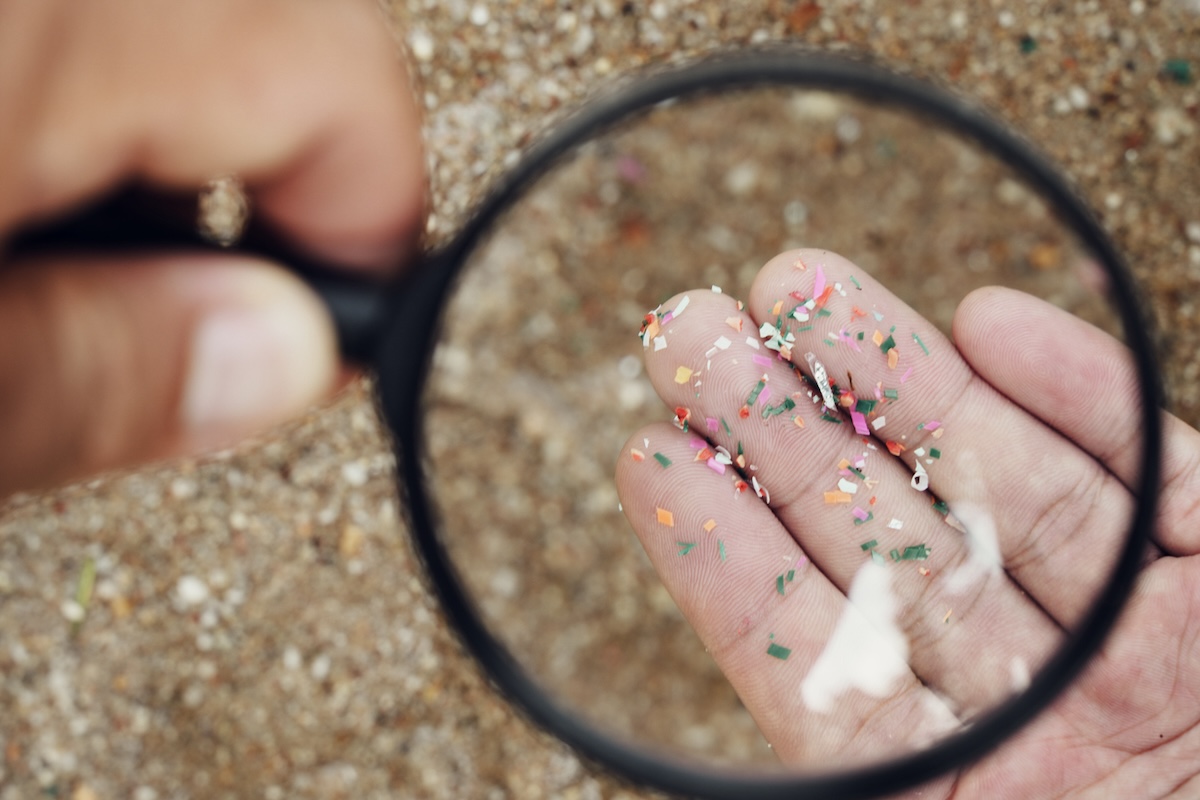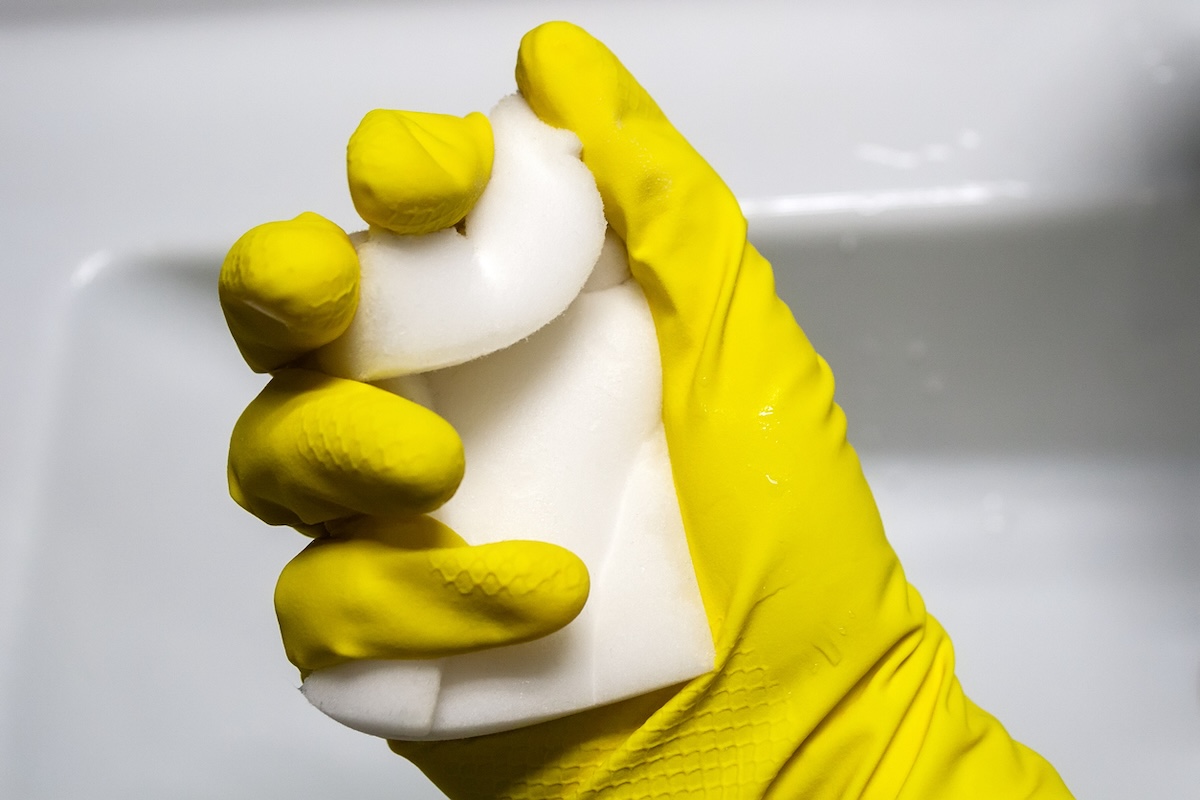We may earn revenue from the products available on this page and participate in affiliate programs. Learn More ›
For two decades, many people who prefer to clean smarter, not harder have turned to the Mr. Clean Magic Eraser sponges—or other brands of similar composition. Made of melamine foam that has undergone heat compression, these abrasive melamine sponges are known for their ability to quickly and easily clean most surfaces.
Originally manufactured in the late 20th century, melamine foam contains hydrogen, carbon, nitrogen, and a formaldehyde-melamine-sodium bisulfite copolymer compound. It also contains tiny plastic particles—microplastics—that end up in the water supply, soil, and food chain as the sponges disintegrate…with unhealthy results.
Cleaning with melamine sponges contributes to the spread of microplastics.
The porous, water-activated melamine sponges disintegrate as a result of friction when they are used, releasing microplastic fibers (MPGs). One recent study estimated that sponge wear could be responsible for the release of 6.5 million MPFs/g, which could accumulate to 4.9 trillion MPFs global emission.
One-third of all plastic waste ends up in the soil or freshwater. Airborne microplastic particles are transported by wind to all parts of the globe. Microplastics also spread through waterways. There are already an estimated 24.4 trillion microplastics in the upper oceans, and researchers predict there will be more than 600 million tons of microplastic in the oceans by 2040.
Microplastics contaminate soil.
Terrestrial microplastic pollution is 4 to 23 times higher than marine microplastic pollution. The use of biosolids (treated wastewater) can introduce several thousand tons of microplastics to soil, where they can change its structure and chemistry by reducing water retention and altering nutrient cycling. They can enter soil through compost, sewage soil, landfills, and plastic mulch, potentially causing food pollution.
Microplastics can also harm fauna and flora, decreasing the numbers of species that live underground. Where they occur in the soil, they can be transported by water to plant roots, stems, leaves, and fruits.

Microplastics contaminate water.
Microplastics are found in 80 percent of water globally. They can enter waterways through rain, air, wastewater treatment plants, from packaging, or from freshwater ecosystems, which spread them to other bodies of water and other ecosystems as well as to the food we eat.
Filtration systems and wastewater treatment plants may capture large particles, but smaller particles typically pass through. To date, boiling has been found to be the best method of helping eliminate up to 90 percent of microplastics from water.
Microplastics impact animals and humans.
Melamine sponges are considered a safe alternative to cleaning chemicals, but a 2021 study found that many plastic particles contain toxic chemicals that interfere with the body’s release of hormones, increasing the risk of reproductive disorders, respiratory illness, and cancer.
Animals may suffer stunted growth, diminished appetite, tissue inflammation, and liver damage. Microplastics can carry toxic compounds on their surface, such as heavy metals. These can be ingested by animals and passed up through the food chain.
People inhale or ingest 114,000 microplastics every year. Nanoplastics are small enough to travel via the bloodstream to enter human organs, leaving humans three times more likely to suffer a heart attack.
Melamine Sponge Alternatives

The best thing to do for the environment, animals, and ourselves is to eliminate or reduce our contribution of microplastics. One start to achieving that goal is to replace Magic Erasers and other melamine sponges with a variety of alternative cleaning options. Pairing biodegradable products with eco-friendly cleaning solutions can be just as effective as melamine sponges—and a whole lot better for the environment.
- Swedish dishcloths: Made from a blend of wood pulp and cotton, they are highly absorbent, washable, biodegradable, and durable.
- Cellulose sponges: Made from wood pulp or plant cellulose, they are absorbent, washable, flexible, soft, and biodegradable.
- Coconut scrubbers: Made from coconut fibers or husks, they are biodegradable, washable, tough, and abrasive enough to be used for heavy scrubbing without scratching surfaces.
- Loofahs: Made from dried gourds, they are biodegradable, washable, gentle, and exfoliating.
- Bamboo brushes: Made of bamboo and natural bristles, they are biodegradable, washable, sturdy, and ergonomic.
- Hemp sponges: Made of hemp fibers, they are biodegradable, washable, durable, gentle, hypoallergenic, antifungal, and antibacterial.
- Agave scrubbers: Made from agave fibers, they are biodegradable, washable, hard, and rough enough to be used for heavy scrubbing, although they’re not recommended for use on delicate surfaces.
- Pop–up sponges: Made from wood pulp or plant cellulose, they are compostable, washable, absorbent, and soft when wet; when dry, they are thin and compressed.


